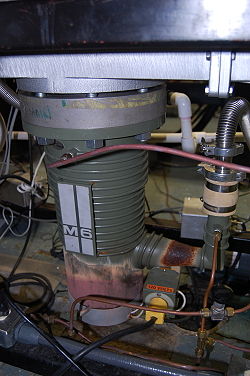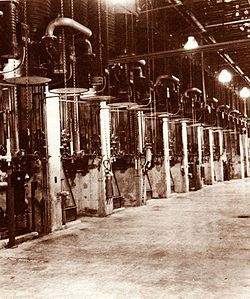
Diffusion pump
Encyclopedia

Molecule
A molecule is an electrically neutral group of at least two atoms held together by covalent chemical bonds. Molecules are distinguished from ions by their electrical charge...
s in the pump throat down into the bottom of the pump and out the exhaust. Presented in 1915 by Wolfgang Gaede and using mercury vapor, they were the first type of high vacuum pump
Vacuum pump
A vacuum pump is a device that removes gas molecules from a sealed volume in order to leave behind a partial vacuum. The first vacuum pump was invented in 1650 by Otto von Guericke.- Types :Pumps can be broadly categorized according to three techniques:...
s operating in the regime of free molecular flow
Free molecular flow
Free molecular flow describes the fluid dynamics of gas where the mean free path of the molecules is larger than the size of the chamber or of the object under test. For tubes/objects of the size of several cm, these means pressures well below 10-3 torr. This is also called the regime of high...
, where the movement of the gas molecules can be better understood as diffusion
Diffusion
Molecular diffusion, often called simply diffusion, is the thermal motion of all particles at temperatures above absolute zero. The rate of this movement is a function of temperature, viscosity of the fluid and the size of the particles...
than by conventional fluid dynamics
Fluid dynamics
In physics, fluid dynamics is a sub-discipline of fluid mechanics that deals with fluid flow—the natural science of fluids in motion. It has several subdisciplines itself, including aerodynamics and hydrodynamics...
. Gaede used the name diffusion pump since his design was based on the finding that gas cannot diffuse against the vapor stream, but will be carried with it to the exhaust. However, the principle of operation might be more precisely described as gas-jet pump, since diffusion plays a role also in other high vacuum pumps. In modern text books, the diffusion pump is categorized as a momentum transfer pump. The diffusion pump is widely used in both industrial and research applications. Most modern diffusion pumps use silicone oil
Silicone oil
A silicone oil is any polymerized siloxanes with organic side chains. They are formed of alternating silicon-oxygen atoms or siloxane, rather than carbon atoms . Other species attach to the tetravalent silicon atoms, not to the divalent oxygen atoms which are fully committed to forming the...
or polyphenyl ethers as the working fluid. Cecil Reginald Burch
Cecil Reginald Burch
Cecil Reginald Burch, FRS was a British physicist and engineer.He was born in Leeds. He graduated from Gonville and Caius College, Cambridge in 1923 and began research at the Metropolitan-Vickers company in Trafford Park, Manchester. There he developed 'apiezon' oils which enabled high vacua to...
discovered the possibility of using silicone oil in 1928.
Oil diffusion pumps
The oil diffusion pump is operated with an oil of low vapor pressure. Its purpose is to achieve higher vacuum (lower pressure) than is possible by use of positive displacement pumps alone. Although its use has been mainly associated within the high-vacuum range (down to 10−9 mbar), diffusion pumps today can produce pressures approaching 10−10 mbar when properly used with modern fluids and accessories. The features that make the diffusion pump attractive for high and ultra-high vacuum use are its high pumping speed for all gases and low cost per unit pumping speed when compared with other types of pump used in the same vacuum range. Diffusion pumps cannot discharge directly into the atmosphere, so a mechanical forepump is typically used to maintain an outlet pressure around 0.1 mbar.
The high speed jet is generated by boiling the fluid and directing the vapor through a jet assembly. Note that the oil is gaseous when entering the nozzles. Within the nozzles, the flow changes from laminar
Laminar flow
Laminar flow, sometimes known as streamline flow, occurs when a fluid flows in parallel layers, with no disruption between the layers. At low velocities the fluid tends to flow without lateral mixing, and adjacent layers slide past one another like playing cards. There are no cross currents...
, to supersonic
Supersonic
Supersonic speed is a rate of travel of an object that exceeds the speed of sound . For objects traveling in dry air of a temperature of 20 °C this speed is approximately 343 m/s, 1,125 ft/s, 768 mph or 1,235 km/h. Speeds greater than five times the speed of sound are often...
and molecular
Free molecular flow
Free molecular flow describes the fluid dynamics of gas where the mean free path of the molecules is larger than the size of the chamber or of the object under test. For tubes/objects of the size of several cm, these means pressures well below 10-3 torr. This is also called the regime of high...
. Often several jets are used in series to enhance the pumping action. The outside of the diffusion pump is cooled using either air flow or a water line. As the vapor jet impacts the outer cooled shell of the diffusion pump, the working fluid condenses and is recovered and directed back to the boiler. The pumped gases continue flowing to the base of the pump at increased pressure, flowing out through the diffusion pump outlet, where they are compressed to ambient pressure by the secondary mechanical forepump and exhausted.
Unlike turbomolecular pump
Turbomolecular pump
A turbomolecular pump is a type of vacuum pump, superficially similar to a turbopump, used to obtain and maintain high vacuum. These pumps work on the principle that gas molecules can be given momentum in a desired direction by repeated collision with a moving solid surface...
s and cryopump
Cryopump
A cryopump is a vacuum pump that traps gases and vapours by condensing them on a cold surface. They are only effective on some gases, depending on the freezing and boiling points of the gas relative to the cryopump's temperature...
s, diffusion pumps have no moving parts and as a result are quite durable and reliable. They can function over pressures ranges of 10−10 to 10−2 mbar. They are driven only by convection
Convection
Convection is the movement of molecules within fluids and rheids. It cannot take place in solids, since neither bulk current flows nor significant diffusion can take place in solids....
and thus have a very low energy efficiency.
One major disadvantage of diffusion pumps is the tendency to backstream oil into the vacuum chamber. This oil can contaminate surfaces inside the chamber or upon contact with hot filaments or electrical discharges may result in carbonaceous or siliceous deposits. Due to backstreaming, oil diffusion pumps are not suitable for use with highly sensitive analytical equipment or other applications which require an extremely clean vacuum environment, but mercury diffusion pumps may be in the case of ultra high vacuum chambers used for mercury deposition. Often cold trap
Cold trap
In vacuum applications, a cold trap is a device that condenses all vapors except the permanent gases into a liquid or solid. The most common objective is to prevent vapors from a vacuum pump from contaminating the experiment or sample of interest. Cold traps also refer to the application of cooled...
s and baffles are used to minimize backstreaming, although this results in some loss of pumping ability.
The oil of a diffusion pump cannot be exposed to the atmosphere when hot. If this occurs, the oil will burn and has to be replaced.
Steam ejectors

The steam ejector is a popular form of diffusion pump for vacuum distillation
Distillation
Distillation is a method of separating mixtures based on differences in volatilities of components in a boiling liquid mixture. Distillation is a unit operation, or a physical separation process, and not a chemical reaction....
and freeze-drying. A jet of steam entrains the vapour that must be removed from the vacuum chamber. Steam ejectors can have a single or multiple stages, with and without condensers
Condenser (steam turbine)
A surface condenser is a commonly used term for a water-cooled shell and tube heat exchanger installed on the exhaust steam from a steam turbine in thermal power stations. These condensers are heat exchangers which convert steam from its gaseous to its liquid state at a pressure below atmospheric...
in between the stages.
Compressed-air ejectors
One class of diffusion vacuum pumps is the multistage compressed-air driven ejector. It is very popular in applications where objects are moved around using suction cups and vacuum lines.External links
- An oil diffusion pump built from glass by the Arizona State University Main
- Oil Diffusion pumps by Donald M. Mattox, Technical Director of The Society of Vacuum Coaters

